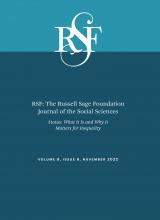Research Article
Open Access
The Architecture of Status Hierarchies: Variations in Structure and Why They Matter for Inequality
Fabien Accominotti, Freda Lynn, Michael Sauder
RSF: The Russell Sage Foundation Journal of the Social Sciences November 2022, 8 (6) 87-102; DOI: https://doi.org/10.7758/RSF.2022.8.6.05
Fabien Accominotti
aAssistant professor of sociology at the University of Wisconsin–Madison, United States
Freda Lynn
bAssociate professor of sociology at the University of Iowa, United States
Michael Sauder
cProfessor of sociology at the University of Iowa, United States

REFERENCES
- ↵
- ↵
- Accominotti, Fabien
- ↵
- Accominotti, Fabien
- ↵
- Accominotti, Fabien
- ↵
- Accominotti, Fabien
- ↵
- Accominotti, Fabien, and
- Daniel Tadmon
- ↵
- Anderson, Cameron, and
- Robb Willer
- ↵
- Anderson, Elizabeth
- ↵
- Anderson, Elizabeth
- ↵
- ↵
- Berger, Joseph,
- Hamit Fisek,
- Robert Z. Norman, and
- Morris Zelditch
- ↵
- Blau, Peter M., and
- Otis Dudley Duncan
- ↵
- Bothner, Matthew S.,
- Edward Bishop Smith, and
- Harrison C. White
- ↵
- Bourdieu, Pierre
- ↵
- Brandtner, Christof
- ↵
- ↵
- Burris, Val
- ↵
- Chan, Tak Wing, and
- John H. Goldthorpe
- ↵
- Chase-Dunn, Christopher, and
- Peter Grimes
- ↵
- ↵
- Chase-Dunn, Christopher
- ↵
- Correll, Shelley J
- ↵
- ↵
- Correll, Shelley J., and
- Cecilia L. Ridgeway
- ↵
- Correll, Shelley J.,
- Cecilia L. Ridgeway,
- Ezra Zuckerman,
- Sharon Jank,
- Sara Jordan Bloch, and
- Sandra Nakagawa
- ↵
- Crane, Diana
- ↵
- Czégel, Dániel, and
- Gergely Palla
- ↵
- Davenport, Lauren
- ↵
- DiPrete, Thomas A., and
- Gregory M. Eirich
- ↵
- Dumont, Louis
- ↵
- Dumont, Louis
- ↵
- English, James F
- ↵
- ↵
- Espeland, Wendy N
- ↵
- Espy, Hannah W., and
- Freda B. Lynn
- ↵
- Freeland, Robert E., and
- Jesse Hoey
- ↵
- Frey, Vincenz, and
- Arnout van de Rijt
- ↵
- Goldthorpe, John H
- ↵
- Goode, William J
- ↵
- ↵
- Gould, Roger V
- ↵
- Guglielmo, Jennifer, and
- Salvatore Salerno
- ↵
- Healy, Kieran
- ↵
- Jacobson, Matthew F
- ↵
- Jensen, Michael, and
- Aradhana Roy
- ↵
- Kick, Edward L.,
- Laura A. McKinney,
- Steve McDonald, and
- Andrew Jorgenson
- ↵
- Krackhardt, David
- ↵
- Lamont, Michèle
- ↵
- ↵
- Lenski, Gerhard E
- ↵
- ↵
- Lynn, Freda B., and
- George Ellerbach
- ↵
- Lynn, Freda B., and
- Hannah W. Espy
- ↵
- Lynn, Freda B.,
- Joel M. Podolny, and
- Lin Tao
- ↵
- ↵
- Marriott, McKim
- ↵
- Menger, Pierre-Michel
- ↵
- Merton, Robert K
- ↵
- ↵
- ↵
- ↵
- Podolny, Joel M
- ↵
- Ridgeway, Cecilia L
- ↵
- Ridgeway, Cecilia L
- ↵
- Ridgeway, Cecilia L
- ↵
- Ridgeway, Cecilia L., and
- Shelley J. Correll
- ↵
- Rosvall, Martin, and
- Carl T. Bergstrom
- ↵
- Sauder, Michael
- ↵
- Sauder, Michael
- ↵
- Sauder, Michael
- ↵
- Sauder, Michael, and
- Gary A. Fine
- ↵
- Sauder, Michael, and
- Ryon Lancaster
- ↵
- ↵
- Smith, Edward Bishop,
- Tanya Menon, and
- Leigh Thompson
- ↵
- ↵
- Song, Xi,
- Catherine G. Massey,
- Karen A. Rolf,
- Joseph P. Ferrie,
- Jonathan L. Rothbaum, and
- Yu Xie
- ↵
- ↵
- Telles, Edward E., and
- Christina A. Sue
- ↵
- Tocqueville, Alexis de
- ↵
- ↵
- Treiman, Donald J
- ↵
- Valentino, Lauren
- ↵
- Valentino, Lauren
- ↵
- van de Rijt, Arnout,
- Eran Shor,
- Charles Ward, and
- Steven Skiena
- ↵
- Veblen, Thorstein
- ↵
- Warhol, Andy
- ↵
- Weber, Max
- ↵
- Whyte, William F
- ↵
In this issue
The Architecture of Status Hierarchies: Variations in Structure and Why They Matter for Inequality
Fabien Accominotti, Freda Lynn, Michael Sauder
RSF: The Russell Sage Foundation Journal of the Social Sciences Nov 2022, 8 (6) 87-102; DOI: 10.7758/RSF.2022.8.6.05
Jump to section
Related Articles
- No related articles found.
Cited By...
- No citing articles found.





